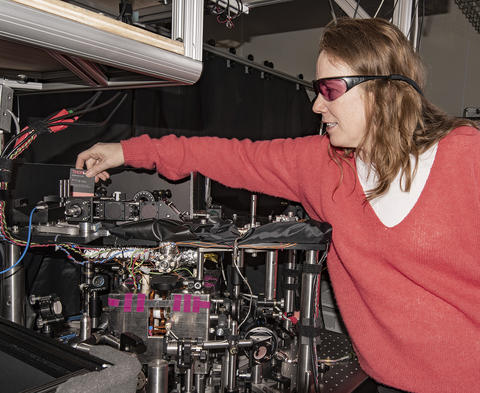Atomic Gyroscopes
The Technology

NIST scientists are exploiting the effects of inertia on the atomic scale to develop exquisitely sensitive, intrinsically accurate motion sensors.
Initially, atoms are cooled and trapped within a glass vapor cell. When the trap is turned off, the atoms begin to expand outward and are excited by laser beams that put each atom into two quantum states at the same time. As the atoms disperse and interact while the cell is in motion, the atoms’ states change differently depending on the direction and strength of the forces caused by rotation or acceleration of the cell.
Each atom’s two quantum states can be imagined as rippling waves. The waves of the atoms reinforce or cancel each other out at various points in the cell to form new interference patterns. This interference determines the atom’s final quantum state and appears as “fringe” patterns projected onto a detector. From those patterns, researchers can deduce acceleration in one direction and rotation in two directions.
NIST scientists are also developing ways to simplify and miniaturize laser-cooling platforms on the scale of microchips, ultimately bridging the gap between the best technologies for cold-atom clocks and sensors in the laboratory and practical implementations for applications in the field.
Advantages Over Existing Methods
Because they rely on the ultraprecise rules of quantum physics, atom gyroscopes have the potential to be significantly more sensitive than their conventional counterparts. Their increased sensitivity can also open them up to new applications not possible for conventional gyroscopes.
Applications
Atomic gyroscopes can enable accurate navigation for submarines, aircraft, missiles, ships and satellites by giving them a way to stay on course when no visual or electronic guidance system is available.
Eventually, when the associated lasers and electronics are miniaturized, the sensor can be put to numerous uses. Among the most intriguing: detecting faint differences in the force of Earth’s gravity from place to place caused by height of the landscape or heavy mineral deposits. So much more than a laboratory curiosity, quantum-based atom inertial sensors open the possibility of new capabilities for geology and industry, among numerous other applications.
Key Papers
A. Hansen, Y.-J. Chen, J.E. Kitching and E.A. Donley. Point Source Atom Interferometer Gyroscope. New Frontiers for Metrology: From Biology and Chemistry to Quantum and Data Science: Proceedings of the International School of Physics 'Enrico Fermi,' Volume 206. 2020.
Y.-J. Chen, A. Hansen, G.W. Hoth, E. Ivanov, J. Kitching and E.A. Donley. Single-source multiaxis cold-atom interferometer in a centimeter-scale cell. Physical Review Applied. July 11, 2019. DOI: 10.1103/PhysRevApplied.12.014019
G. Hoth, B. Pelle, S. Riedl, J. Kitching and E.A. Donley. Point source atom interferometry with a cloud of finite size. Applied Physics Letters. Aug. 19, 2016. DOI: 10.1063/1.4961527
S. Riedl, G. Hoth, B. Pelle, J. Kitching and E.A. Donley. Compact atom-interferometer gyroscope based on an expanding ball of atoms. Journal of Physics: Conference Series. June 2016. DOI: 10.1088/1742-6596/723/1/012058
Contacts
-
(303) 497-4083

